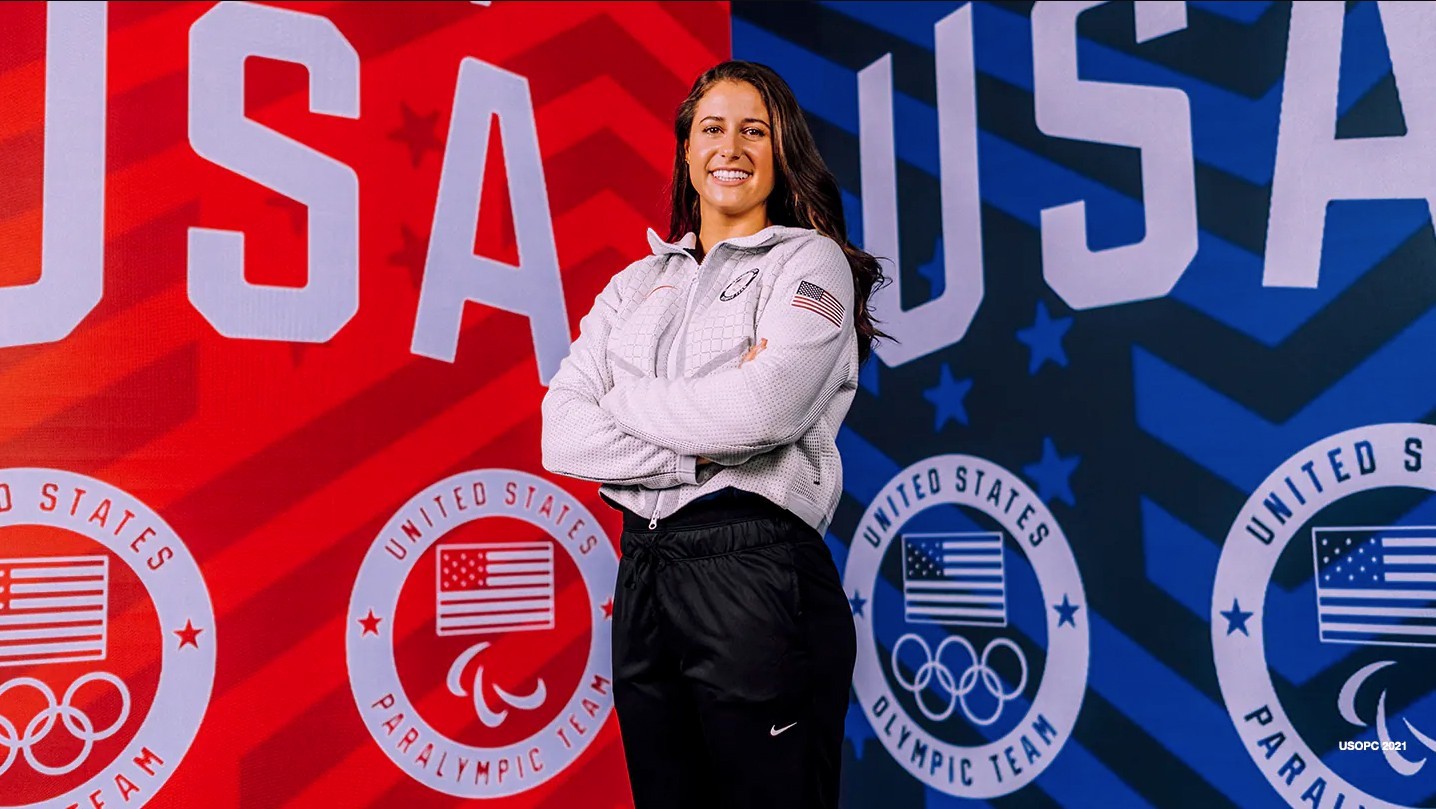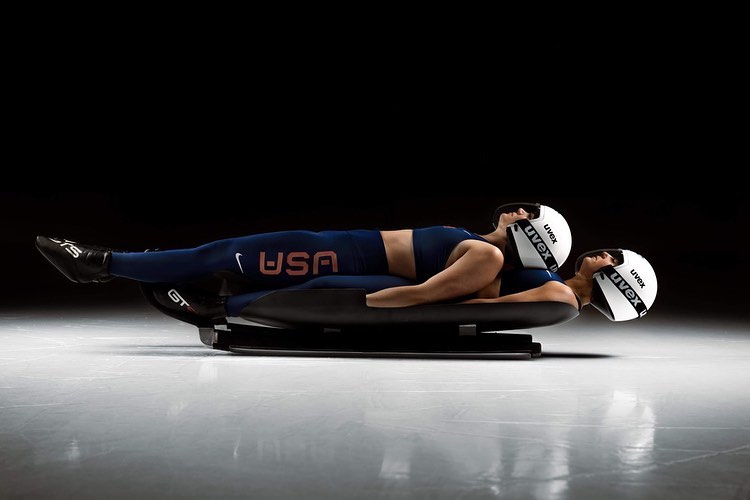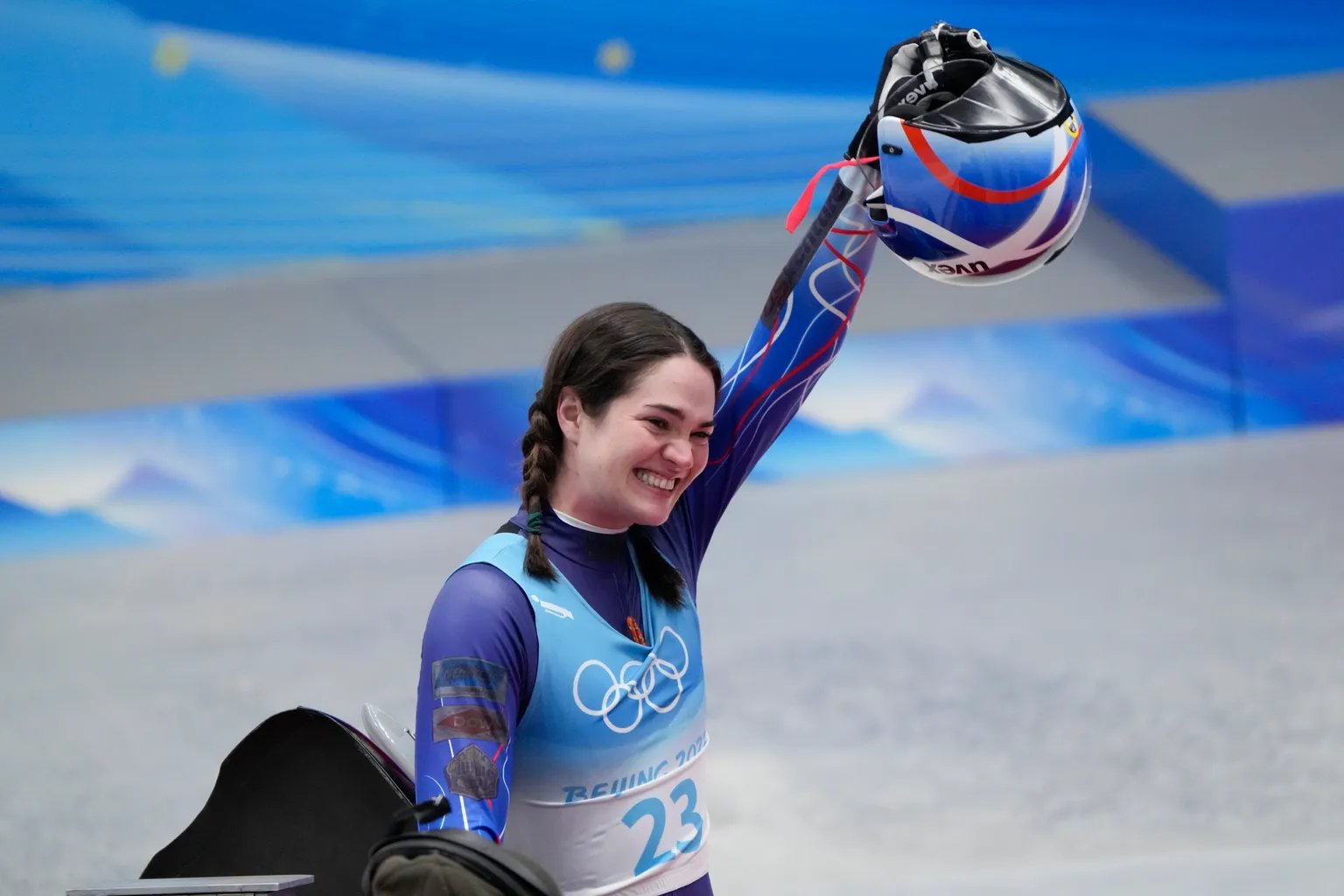.jpeg?width=1440&height=960&name=repost-summerbelle-CkrDcfYu0zF%20(1).jpeg)
(L-R) Summer Britcher and Emily Sweeney. Credit: Jimmy Reed
When the International Olympic Committee announced in June that it would officially accept women's doubles luge as a Winter Olympic Games event, Parity athletes Summer Britcher and Emily Sweeney only slightly hesitated before teaming up to take on the challenge.
The two are already multi-time Team USA Olympians in singles, and are currently training in Europe ahead of their doubles debut at the World Cup in Austria.
They spoke with Olympic silver medalist in the sport of bobsled, Lauren Gibbs, on their decision to try something new, their thoughts on closing the opportunity gap for women, and their hopes for getting more sponsors in the space.
Lauren Gibbs:
Today we have two very special guests, not only because of what's going on with them but also because they're two of my very good friends and I love chatting with people that I love. We have Emily Sweeney and Summer Britcher.
Summer and Emily are luge Olympians. Between the two of them, they've been to five Olympics and they will be going toward their next one in 2026 with a new opportunity to win a medal.
So ladies, first of all, welcome. for those in the Parity family that don't know what luge is. And then we'll chat a little bit about what's going on in your world right now.
Summer Britcher:
Luge is basically really, really extreme sledding. It's on the same track that bobsled competes on. It's an ice track of banked curves about a mile long. And the really cool thing is it's the fastest sport on ice and it's timed to the thousandth of a second. So it's all about perfection. Chasing down these tiny little corrections, these tiny improvements, year after year, training run after training run, to try to get those tiny blinks of an eye amount of time, and try to get those medals when we can.
Lauren Gibbs:
That is a great description, but you make it sound calm. Now, I've been on a luge sled, and I think I almost broke my foot because I made the mistake of turning my head and that sent the sled into a skid. So when Summer says “extreme,” she means it. Extreme.
I wish everybody could try luge to have more respect for what you all do day in and day out for years because both of you have been luging for most of your lives. Right?
Emily Sweeney:
Yes. Tucker, my teammate, was kind enough to remind me that this was my 20th first run of the season this year. I'm 29, so it's been a while.
Lauren Gibbs:
You guys need those first day of school signs, like, "29th First Day of Sliding."
Emily, let's talk a little bit about what is new in the world of luge.
Emily Sweeney:
So in June, the IOC— the International Olympic Committee— approved women's doubles for the 2026 Winter Olympic Games.
Up until this point, our Olympic team has been, traditionally, about 10 athletes and 70% of them were men. So now there's an opportunity for more women to be on that team and there's a whole other discipline that's available to us.
Lauren Gibbs:
That's exciting for a number of reasons. I think obviously talking with Parity— equity, equality, is a big deal in our world. Opportunities for women, the ability to go after another medal opportunity, are all very important things.
Let's talk a little bit about it from the standpoint of athletes who have been doing this sport for most of their lives.
What does it mean for you, both individually and together, to get the opportunity to do this within your career? Because I'm sure this has been a conversation for a long time, but maybe you thought this isn't something that you would see in your lifetime as a luge athlete.
Summer Britcher:
It's been incredible, the success of growing this new discipline. We've seen it in a few different sports where they're faced with this push from the IOC. They say, "Hey, we want gender equality going forward in the Olympics. We really want to make a push for that and for equal opportunity for men and women." And it's a tough thing.
How do you build out a whole discipline? And I think it was five or six years ago, the International Luge Federation started implementing this new discipline—women's doubles—on the youth tour and then the junior tour.
And this is the first year it will be with the World Cup tour as its own World Cup event with women's singles, men's singles, and men's doubles.
I didn't know if I was going to retire after this past year, or what would happen. Emily and I have been joking about this for a bit of time. It was first brought up to us maybe three or four years ago. Someone said, "Hey, you guys should do doubles."
And we said, "No, we're both really focused on singles, one-track mind." You know us, we were competitive, we're training for this, this is what I'm sticking with.
But seeing this opportunity grow and the participation, it started being something to be excited about and to have on the back burner of my mind.
I started teasing Emily about it about a year ago. I started saying, in front of our coaches, "Emily, it's just you that's stopping us. We could go do doubles. It's just you. I would do it. I'm saying yes." And then Emily called my bluff this spring and she messaged me and she said, "Okay, let's do it," which I was not expecting.
I'm so happy that she did and that we committed to it because it has been a ton of fun so far.
Lauren Gibbs:
That might be the most Emily and Summer story I've ever heard. For those that know you, I'm sure they are laughing. So Emily, what was it that made you say, "Yeah, let's do it"?
Emily Sweeney:
I think it's funny when people would bring it up to us before, because they saw our strengths as individuals, and they said, "You guys would make a really good doubles team."
Our height difference, our individual strengths on the sled, how we drive, how we approach things in sliding, we're very different. We operate very differently, but we're both incredibly intentional about the way we do things. And I think that our coaches saw that potential.
And at first, I think both of us had a similar sentiment of saying something along the lines of, "We've both worked really hard to become good at something already."
We've gone through that learning curve, and honestly the idea of hitting a bunch of walls again and going through... because it is very different. So it's the same sport, but it's a whole different dynamic. So the idea of starting over was not appealing to me at all.
And then at some point after the 2022 Olympics, I got excited about learning something new in the sport. It reinvigorated things. And the idea of starting a new challenge within luge and learning how to apply what I've already learned and developed, I just got excited about the idea. And then, I was calling Summer's bluff, but part of me knew that there was still a chance that she would say, "No, you're crazy." So I think it's kind of funny that we both, as soon as we said yes, we just hopped on it.

Emily Sweeney. Credit: Team USA
Lauren Gibbs:
That's the benefit of having known each other since you were 10 years old. You know how each other's going to react and that's amazing.
You brought up a little bit about the sled. For someone who doesn’t know how a double sled works, Summer, can you explain what a double sled is like and the positioning that you guys have to get into executing this discipline?
Summer Britcher:
Sure.
The I always heard it described—the difference between singles and doubles in the same sport—was like driving a Ferrari versus driving a school bus. And that's a little bit accurate.
The double sled is longer, so you can fit both of us on top of it and it comes up a little higher. So Emily is the bottom woman or the bottom driver, and she's laying in the sled. She has contact with what we call the pod or the shell of the sled. When she shifts her body on that, it gives some really solid steers that can get us out of a lot of trouble. It can really set the sled going in the right direction. And then I have a little seat. And I lie back on top of her, positioned a little bit further in front of her for aerodynamics, where our heads line up so we can work together to shift those weights and steer.
So the center of gravity's higher, and the weight of the sled is higher. You got two people. You can't communicate. We don't have microphones where I can say, "Oh hey, I need some help..." You can't yell, you can't try to communicate or have some code, you just have to be in sync. And it's been really cool to have that team aspect in sport again. It's something I've really missed these last many years.

Credit: Jimmy Reed
Lauren Gibbs:
I think the thing for me that is the most terrifying about luge is how you guys start. With bobsled, we're pushing. It's still unnatural, but it's a more natural way of taking off. For the two of you, you use your arms, shoulders, core, all that good stuff. But really it comes down to spikes on what, three fingers? Four fingers?
Emily Sweeney:
Yes. Six. So these six fingers.
Lauren Gibbs:
Yes. Right. Six fingers. And so I can imagine it's complicated doing it by yourself. Now there's the added complication of making sure that you guys are in rhythm and aren't spiking each other.
Can you talk a little bit about what the start is, first of all, in luge, and then what it's been like having to communicate in that way?
Emily Sweeney:
It’s completely different. But at the same time, a lot of our strengths as single sliders have transferred over. So essentially in a luge start you use your body like a slingshot.
We have handles that we pull off from and you push yourself all the way back and you try and shoot yourself forward and then you go and use your arms as you would use your legs and you paddle down the ramp. So you mentioned spiking. The risk of spiking comes from the bottom slider hitting the top slider. So I have spiked Summer multiple times and I feel terrible about it every time. She's really understanding. She's been very gracious about it. But that learning curve of just becoming in sync with someone, it's been real.
The start itself was more natural than I expected it to be. I think just through our years of strength training in the gym as well, the way that we move our body, it's very mechanical. And so that transferred over pretty well for us. But getting in sync on the paddles has taken time to get used to. And then settling beyond that.
Lauren Gibbs:
That's awesome. That leads perfectly to my next question. You guys are preparing to debut as a duo next month in the World Cup in Innsbruck.
What does that preparation look like, and how does that preparation change now that you're competing together?
Summer Britcher:
It has definitely amped up the excitement. As far as preparation goes, I'd say a lot of communicating, a lot of talking, which is something that we really developed a fantastic way... to be teammates for so many years, you have to find a way to really work together. We really are lucky to have a great team dynamic on the whole team.
It's something we see with a lot of new teams. They can struggle with that communication.

Summer Britcher. Credit Getty Images
Looking at our first race weekend, we could potentially have eight race runs in three days, which is wild because normally we're looking at two to three race runs in a weekend. So we're really just trying to anticipate what we can and roll with the rest.
Lauren Gibbs:
That's amazing. Eight race runs. That's like two Olympics for me. Eight race runs in a weekend, that's a lot. But so exciting
I think we’d be remiss not to talk about the opportunity from a sponsorship level. Obviously, Parity's mission is to close the pay gap in sponsorship support for women athletes. What does this mean for you in terms of opportunities to capture more sponsors?
You mentioned eight races in a weekend. That’s eight opportunities for logos of companies to be seen, to represent an organization, and to win a medal for that organization. So what does that mean for you as far as investing in women luge athletes from a sponsors' perspective?
Summer Britcher:
Honestly, it means so much.
It can be really challenging to go about being in this niche sport alone and trying to navigate those things. Hopefully, we can find somebody to partner with who sees the value in women's sports, and who sees this as an opportunity to have the opportunity for more opportunities.
Which sounds cheesy. But it is-
Emily Sweeney:
It's important.
Summer Britcher:
It is a massive sponsorship opportunity. And we're seeing the growth already in our sport. We're seeing more women participate.
We have these two young teams who competed in the women's doubles World Cup last year that we'll be competing with. And we're seeing... we have, I think, more women on the road at this point than men, or close to.
Emily Sweeney:
Which is the first time ever in my very long career. And I think, to touch on what Summer said, the excitement that we've seen and felt from people has been so much fun. We have the team people that we've created, too, to help us along this journey with access to sled equipment and everything.
It's been a process and every time we've come up with a challenge, which there have been many already with just getting started. It's been so exciting to see the way that we've pushed through and overcome all of the logistic challenges that come with starting something new. And then on top of that, the way that we announced it. And we had these great pictures from Jimmy Reed and that-
Summer Britcher:
Fire.
Emily Sweeney:
Thank you. Honestly, he did such a good job. And the amount of people that were just so stoked about it was so fun.
We hope that that translates into sponsorship as well because we've felt that power with other people already. And I think that, as you said, it's Parity's mission too. It's just recognizing that and figuring out a way to leverage it.
Lauren Gibbs:
Of course, you're crushing it. I expect nothing less out of two of the first athletes I met when I started bobsled in 2014 at the Lake Placid Training Center. You guys were so welcoming and so knowledgeable and so supportive. I have no doubt that you will navigate this new challenge and opportunity in the same way, which is great.
Anything you want to say in closing before we wrap up?
Summer Britcher:
Just thank you to everyone who's gotten excited with us, everyone who tuned in, everyone who does support women's sports and equality. It really does mean something and it makes a difference.
Emily Sweeney:
Yes, it's been unexpected to be a part of this conversation in the way that we are. We've been fortunate in that there isn't a pay gap in luge with gender. But like we said, there was that opportunity gap. And so it's been unexpected that we're a part of this in this way and it's really exciting and I'm happy to be here. We're excited about all of the support that we've had. So thank you.
This interview has been edited and condensed for clarity. Watch the entire conversation here.
Follow Parity on Instagram, LinkedIn, Twitter, Facebook, and TikTok to stay up-to-date on news surrounding elite women athletes and sports marketing.

